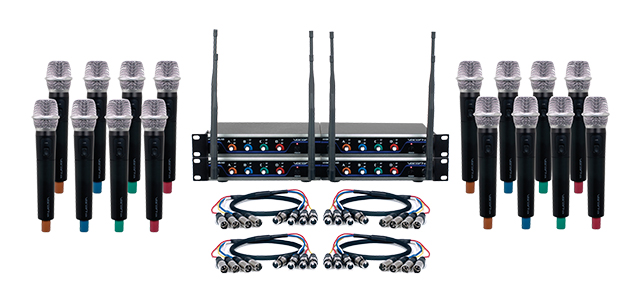Whether you’re looking to rock the house or nail a presentation, everyone needs a good, reliable microphone. However, not all wireless mics are created equal. Although many deliver in terms of sound quality and intelligibility, wireless mics, taken as a whole, still have a reputation for falling short in the reliability department. Wireless systems can often be tricky to set up for larger productions, and they’re subject to interference from radio and TV signals, as well as other microphones and numerous other wireless devices.
VocoPro had wireless mics’ less-than-reliable reputation in mind as it designed its latest wireless mic offering, the Hybrid line, which includes the Hybrid-Play and Hybrid-Acapella systems. According to VocoPro’s President, Jason Hou, “With the Hybrid line, we wanted to give customers a good-quality, reliable, affordable, easily configured wireless microphone system.” However, devising a high-quality mic system wasn’t enough for VocoPro; the company also wanted to improve dramatically the end-user experience of using a wireless mic system. “Great products alone don’t keep customers happy,” Hou said. “The customer is paying for an experience, and the product is the gateway for that to take place.”
Hou’s emphasis on providing a positive experience for end users is reflected in VocoPro’s general approach to designing new products and, in particular, the Hybrid line. “Our process centers on listening to our customers and determining the challenges they face, and then working to solve their problems better than everyone else can,” he offered. “I think what sets VocoPro apart is our laser focus on meeting customer needs, rather than just creating new products because we can.”
Because of that focus on the customer’s needs, the designers behind the Hybrid line were fully aware of consumer complaints relating to how difficult wireless mic systems can be to set up and use reliably. In order to address those complaints, VocoPro decided to devise a system that would handle much of the configuration process by itself, with minimal user input. “It’s easy to plug in one or two mics,” Hou said. “But, when you need a larger number of mics, wireless systems can be quite expensive and difficult to set up and operate. It takes a lot of time to set them up to avoid cross talk and interference. Our system manages that for the user. It is truly plug and play.”
Hou elaborated further on the user-friendliness of the Hybrid line, explaining, “There is no need to configure channels or anything complicated. Because the frequencies on each channel are fixed and unique, they are designed not to interfere with each other. That also effectively solves the problem of syncing a wireless mic to a transmitter.” He added, “It’s nice when everything just turns on and works, without a lot of steps in between.”
VocoPro’s Hybrid line systems can offer that degree of automation because of a few unique hardware features. “The most interesting component in the hybrid-quad system is a tiny integrated circuit called ‘mic-on-chip,’” Hou explained, “which saves users hundreds on component and manual adjustments.” He continued, “Plus, the digital circuit really gives us much better signal-to-noise ratio, resulting in a better-quality microphone sound overall, and at a lower cost than was possible before. Then, we can pass those savings on to consumers.”
In addition to improved reliability and streamlined configuration, the Hybrid line boasts an impressive amount of wireless mic channels. Hybrid-Play and Hybrid-Acapella systems are available in eight-, 12- or 16-channel configurations. According to Hou, channel count was a major consideration in the Hybrid line’s design process. “These products were in development for a little more than a year,” he explained, “but we started to develop the line based on feedback from our four-channel analog systems. That eventually led us to the 12- and 16-channel capability when our hybrid chip came out.”
VocoPro’s Hybrid mic systems further improve usability and reliability by operating in the 900-megahertz frequency band. That means the wireless mics will not be affected by TV broadcast interference, and they’ll be less susceptible to interference from other wireless devices, as well.
With respect to sonic performance, the Hybrid line packs plenty of punch. The systems boast 24-bit digital audio functionality. And, owing to the “mic-on-chip” technology, they can reproduce clear, crisp sound across a 200-foot range. The systems also offer a balanced XLR output for each channel, enabling more precise volume control. And, users can patch in all the system’s microphones using quarter-inch mixed outputs.
Because the Hybrid systems might be more complex than other mic systems to which MI retailers are accustomed, VocoPro will be sending special educational materials to its dealers nationwide, as well as working with them on a one-on-one basis to make sure they understand—and can effectively communicate to customers—what the company calls “the VocoPro difference.”
Hou anticipates that both the Hybrid-Play and Hybrid-Acapella systems will be big hits with end users. “So far,” he said, “the feedback from customers has been positive. People generally like the hybrid technology that combines digital processing with analog UHF transmission, mainly because it gave the product the qualities of a much more expensive microphone. Also, the plug-and-play functionality is very important to users. We’ve even had good reviews from church musicians who were able to set up their microphones without any help from their sound man!”
VocoPro’s Hybrid-Play and Hybrid-Acapella wireless mic systems are available now in a variety of channel options. Eight-channel systems have an MSRP of $799, whereas 12-channel and 16-channel systems cost $1,199 and $1,599, respectively. Hybrid-Play systems feature headset/lapel mics, whereas Hybrid-Acapella systems feature handheld mics.


